Call Director (Site)
Call Director
Description
Call Director is a fixed-mobile convergence (FMC) solution that allows users to make and receive calls using one number on any device and move calls between devices.
Function
The Call Director user feature allows the user to define one or more phone number locations e.g. a Mobile Phone (also referred as Call Director locations in this document) that can be used as extensions to the user’s account. These numbers are all alerted for inbound calls, similar to the Simultaneous Ring/Remote Office feature. Call Director supersedes the Simultaneous Ring feature.
There is also the Call Director portal, which is a Site level Feature that:
- Allows users to make calls via the Call Director Portal from any Call Director location and present their business number
- Move calls from their device/locations to any Call Director location
The Call Director portal allows Users to make outbound calls from any phone using their IC-Talk 3 service. Once the passcode and destination digits are collected by the Call Director Portal, the call proceeds as if the call originated from the user’s desk phone.
Call move/handover functionality is provided by a Call Director Call Move feature access code. When dialled from a User’s device the active call is moved to that device. This feature access code can also be dialled via the Call Director Portal to move the call to a Call Director Location.
Feature Components
Call Director User Feature
The Call Director User Feature allows the user to configure Call Director locations. A Call Director location is a phone number in national format e.g. 07123456790. A Call Director location can be enabled or disabled from the Business Portal or by using the Location Control Feature Access Codes. The following attributes are also configurable for each Call Director location:
Require Answer confirmation – This attribute determines whether the user is prompted for answer confirmation when a call leg is extended to the Call Director location and is answered by the user.
In addition to these options, the user can configure Call Director locations to be alerted for Click-to-Dial calls. The Alert all locations for Click-to-Dial call attribute applies to all configured Call Director locations.
For more information regarding the configuration and use of the Call Director user feature, see the sections below.
Call Director Portal
The Call Director Portal is a Site Feature that handles incoming calls from the Call Director locations and ultimately prompts for the destination address (the number to be dialled).
The CP, Customer or Group administrator creates the Call Director portal instances at the Site level in the Business Portal. A Site may consist of one or more Call Director portals, each with their own characteristics.
A Call Director portal instance is configured similarly to other Site features. The following options are also available specifically for Call Director portals:
Scope – This attribute determines the scope of the Call Director Portal.
- If the scope is set to “group”, then only users configured in the same Site as the Call Director portal may use and originate calls through the portal.
- If the scope is set to “enterprise”, then all users configured in the same enterprise as the Call Director portal may originate calls through the portal.
Depending on the type of Call Director deployment, an administrator may need to provide multiple access points to Call Director users. For example, if the service is meant to be uniquely available in different Sites, then the administrator may want to provide an access point in each Site to increase the likelihood that the calling address will be available to the Call Director Portal.
There are two mechanisms that can be used by an administrator for creating the access points.
Define a distinct Call Director Portal instance for each access point. Each Call Director Portal instance has a distinct phone number and distinct attributes (for example, scope is limited to Group).
Assign the Alternate Numbers to a Call Director Portal instance and define an access number for each access point. In this case, all access points share the same Call Director Portal instance configuration.
For more information regarding the configuration and use of Call Director Portal instances, see the sections below.
Configuration
Call Director Portal-Site Feature
The Call Director Portal Site Feature is available to configure in the Business Portal under:
- Service > Sites > Feature Settings > Call Director
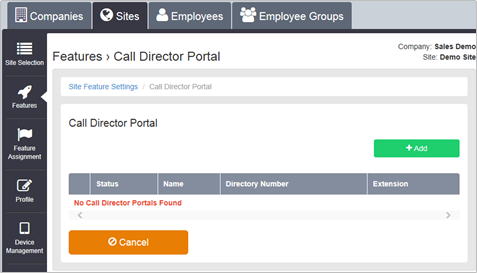
Multiple Call Director Portals can be created under a Site. Each of these Call Director Portals has its own Profile and Settings pages.
- To create a Call Director Portal click ‘Add’
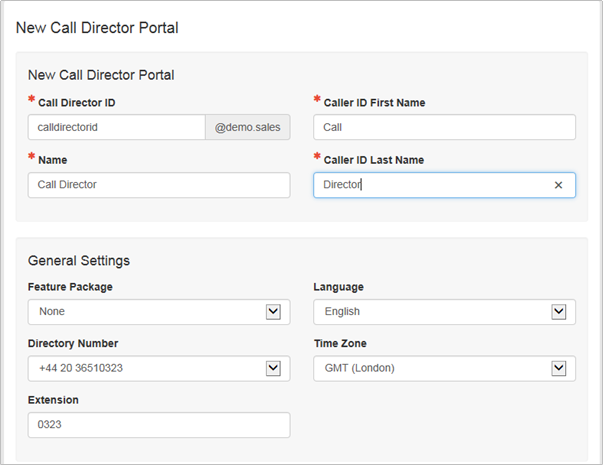
Enter the required details and select a Directory Number to assign to the Call Director Portal. This will be the number that Users will dial to access the Call Director Portal to make calls or use Call Move from their Call Director Locations. Select whether the Portal will be available to the whole Customer or just the Site by selecting ‘Can Be Used By’ Enterprise or Group respectively.
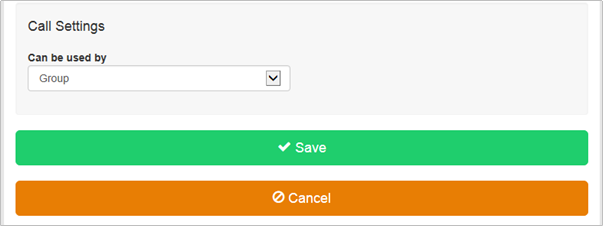
Call Director –User Feature
The Call Director User Feature is available to configure in the Business Portal under:
Employees > Feature Settings > Call Director
A new Call Director Number / Location can be added by clicking the +Add button
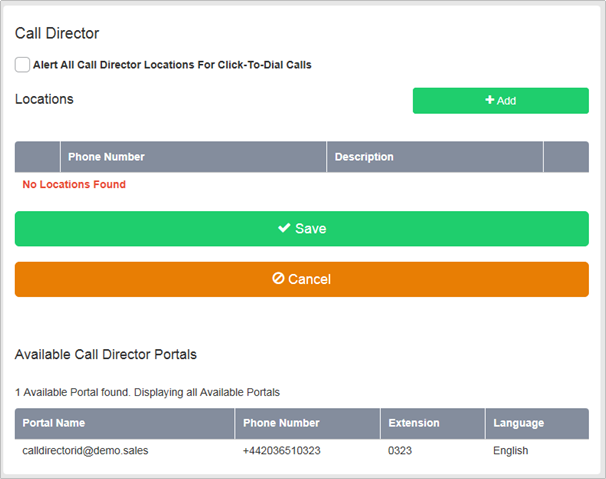
Multiple Call Director Numbers can be added and configured separately. All Call Director Numbers are alerted simultaneously, when enabled, for inbound calls. Call Director Numbers can use the Call Director Portal to make calls and use the Call Director Call Move Feature and Feature Access Codes.
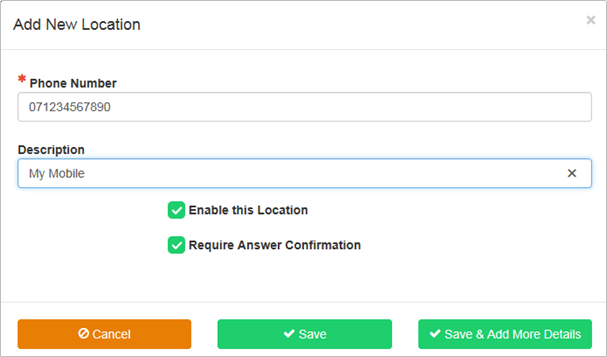
- Enter the Call Director Phone Number (Location) in national format and optionally enter a Description for the Number/Location, then optionally select ‘Require Answer Confirmation’.
- Click ‘Save’ or ‘Save & Add More Details’ to add this Number/Location to the Call Director Service.
- To add subsequent Call Director Numbers click the Add… button and follow the above steps.
Once a Call Director Number is added Selective Criteria or ‘Rules’ can be added to the Number to specify when the Call Director Number should be active and the Number alerted for inbound calls.
Call Director Numbers can be modified e.g. Enabled/Disabled, Answer Confirmation Enabled/Disabled as required.
Disabled Call Director Numbers are not alerted for inbound calls, Click-to-Dial originations etc.
Call Director Numbers can be deleted by selecting the Number and clicking the Delete button.
Once a Number has been added to the Call Director User Feature, other Users will be forbidden from using the same number.
Operation
Call Director Inbound
Inbound calls are forked to the user’s Call Director locations. The user may have multiple Call Director locations configured. Each Call Director location is configured individually with optional selective criteria that determine whether a Call Director location can be alerted for a given call termination.
Each Call Director location can also be enabled or disabled for call terminations in the Business Portal or by using the Location Control Activation or Deactivation (default *12 and *13 respectively) Feature Access Codes.
Enabled Call Director locations are alerted in parallel to the user’s primary location and the alternate locations configured via the Shared Call Appearance feature. To alert a Call Director location, the platform uses the Call Director phone number configured for the location.
If the user answers from a Call Director location that has the Answer Confirmation Required attribute enabled, then the platform connects the Call Director location to an Interactive Voice Response (IVR) session and prompts for confirmation. This capability of requiring answer confirmation is introduced in Release SDAB of the Service Delivery Platform in the context of the Simultaneous Ringing and Sequential Ring services. This capability is extended to Call Director locations through a configuration option of the Call Director user feature. The behaviour of this capability is the same as it is for the other forking services. If the user confirms by dialling a key, then the Call Director location is connected to the calling party; otherwise the Call Director location is released. Note that the Answer Confirmation Required attribute may be configured for more than one Call Director location. In this case, the first Call Director location to confirm on answer always gets connected, while the other locations are released.
Call Director Outbound
The user originates a call from a Call Director location through a Call Director Portal or using a call client (that is, Click-to-Dial). Click-to-Dial originations are processed in a similar way as call terminations (Call Director Inbound) and are described in the above section.
This section describes the behaviour when the user originates calls from the Call Director location by dialling through a Call Director Portal.
The user dials into the Call Director Portal, which is primarily responsible for collecting the destination digits. Once the User’s passcode (same as Voice Mail PIN) have been entered and the destination digits are collected, the Call Director portal resumes the call origination through a redirection mechanism, as described in the sub-section that follows. The call origination is resumed as if the call was originated from the user’s desk.
The process is as follows:
- The user calls the Call Director portal from the Call Director location.
- The Call Director portal handles the incoming call and attempts to identify the user from the calling number
- The calling number is then used to look up a Call Director location. If the calling number is not available, then the calling party is prompted for the calling number.
- If the Call Director portal prompts for the calling number, then the entered digits are resolved and a Call Director location is looked up from that number.
- The Call Director portal validates the scope of the calling number.
- If the Call Director portal scope is set to “enterprise”, then the user identified by the calling number must be in the same Customer as the Call Director Portal.
- If the Call Director portal scope is set to “group”, then the user identified by the calling number must be in the same Site as the Call Director portal.
- Once the user is identified from the calling number, then Call Director Portal prompts for a passcode and prompts for a destination address.
- The user enters the same passcode used for the voice portal (Voice Mail) and the Call Director Portal. The passcode is configurable from the Business Portal via Service Settings > Service Passwords or from a Voice Portal menu. If the entered password is invalid, locked, or expired, then the call is released and an appropriate message is played to the caller. If the user enters an invalid calling address or an invalid password, then the user is allowed to retry twice.
- The Call Director Portal prompts for destination digits. If the user fails to enter the destination digits prior to the digit-collection timeout, then the call origination proceeds with no destination digits, and the caller eventually hears the dial tone timeout treatment.
- Once the user is identified and the destination digits are collected, the call to the destination party is connected.
If the user is already active on a call from a different location and attempts to originate a call from a Call Director location, then the call origination is rejected unless the destination number is for the Call Director Call Move FAC. In the latter case, the Call Director Call Move FAC is handled as described in the section Call Director Call Move and Location Control below.
Click-to-Dial Calls
Call Director locations are alerted for Click-to-Dial originations if the Alert All Locations for Click-to-Dial Call attribute is set. A call leg is created for each Call Director location similar to an inbound call termination, and Auto-Answer is disabled for the call leg to the primary location. Auto-Answer is a function that allows a Click-to-Dial origination to proceed from the primary location without ringing the phone.
The Call Director location’s optional time-based selective criteria are considered for Call Director locations are alerted for Click-to-Dial originations if the Alert All Locations for Click-to-Dial Call attribute is set. A call leg is created for each Call Director location similar to an inbound call termination, and Auto-Answer is disabled for the call leg to the primary location. Auto-Answer is a function that allows a Click-to-Dial origination to proceed from the primary location without ringing the phone.
The Call Director location’s optional time-based selective criteria are considered for Click-to-Dial originations. In addition, if the Call Director location is disabled, then that Call Director location is not alerted. The Request Answer Confirmation attribute operates in the same way as an inbound call termination to the Call Director location.
Call Director Call Move is performed by dialling the Call Director Call Move Feature Access Code (FAC). The default FAC is *11.
The Call Move FAC can be dialled from a User’s Primary or Shared Call Appearance device to move the call to the device. The User can also dial the FAC through the Call Director Portal to move the call to a Call Director Location.
An example of each scenario is shown below.
Moving a call from a Call Director Location to a User’s Primary or SCA Device
User A is on a call with Party B using a Call Director Location and the call was made via the Call Director Portal.
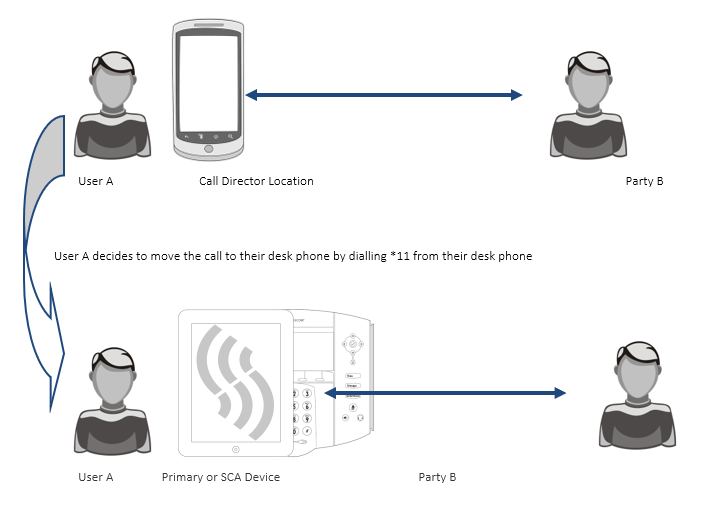
Moving a call from a User’s Primary or SCA Device to a Call Director Location
User A is on a call with Party B using their primary or shared call appearance device.
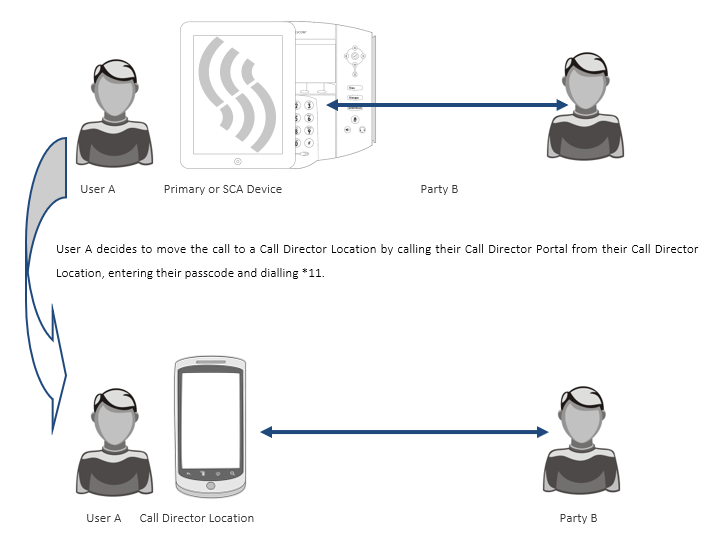
If the user dials the Location Activation FAC via the Call Director Portal, then the Call Director location is activated for inbound call terminations and an activation message is played to the user. From that point, the user may hang up or wait to be disconnected.
If the user dials the Location Deactivation FAC via the Call Director Portal, then the Call Director location is deactivated for inbound call terminations and a deactivation message is played to the user. From that point, the user may hang up or wait to be disconnected.
Example Uses
Outbound Calling through Call Director Portal
The user has a mobile phone configured as a Call Director location. The user dials in to the Call Director portal from the mobile phone. The Call Director portal recognizes the calling number and identifies the user. The Call Director portal prompts the user for a passcode and destination digits. The user enters the passcode and the destination digits.
The call origination is resumed using the destination digits collected by the Call Director Portal. The called party receives and answers the incoming call. The user is connected to the called party.
The user has a mobile phone configured as a Call Director location and receives a call. The user’s desk phone and mobile phone start ringing. The user answers from the mobile phone and gets connected to the calling party.
Inbound Call with Answer Confirmation
The user has a mobile phone configured as a Call Director location and the mobile phone is turned off. The user receives a call and the desk phone start ringing. The incoming call is extended to the user’s mobile phone and is connected to a treatment provided by the user’s mobile phone provider. There is a prompt for confirmation, which never occurs because the call is connected to treatment. The call leg to the mobile phone is released and the incoming call is eventually answered from the user’s desk phone.
The user has a mobile phone configured as a Call Director location and uses a call client (e.g. Toolbar) to originate a call. The option to alert Call Director locations for Click-to-
Dial is enabled so the user’s desk phone and the mobile phone both start ringing. The user answers from the mobile phone and the call origination proceeds to the called party. The user hears ring back until the called party answers, at which point the user is connected to the called party.
The user has a mobile phone configured as a Call Director location and is already active on a call from the desk phone. The user dials in to the Call Director Portal from the mobile phone and dials the Call Director Call Move FAC. The user is connected to the remote party on the mobile phone, and the desk phone is released.
The user has a mobile phone configured as a Call Director location and wishes to disable the location temporarily. The user dials in to the Call Director portal from the mobile phone, and dials the Location Control Deactivation FAC. The user hears confirmation that the location is disabled and hangs up.
Incoming calls to the user are presented to the user’s desk phone, but not the mobile phone.
Later, the user wants to re-enable the Call Director location. The user dials in to the Call Director portal from the mobile phone and dials the Location Control Activation FAC. The user hears confirmation that the location is enabled and hangs up.
Incoming calls to the user are now presented to the user’s desk phone and mobile phone.
This section provides details regarding specific feature/service interactions. Note that when the user originates a call through the Call Director portal, the user’s originating services are executed as if the call had been dialled from one of the user’s primary or shared call appearance location.
If the user attempts to originate a call from a primary or shared call appearance location while already active on a call from/to a Call Director location, then the call origination is rejected.
The user’s primary and shared call appearance locations are alerted in parallel to the user’s Call Director locations. When a user answers the incoming call from any location, then the other locations are simply released.
The following table lists the service interactions between the Call Director User feature and other user features. (Note that if a service is not listed, it means that there are no specific interactions between Call Director and that feature.)
|
Feature |
Interaction Description |
|
Call Centre |
The Call Director feature will send calls from a Call Centre to the Agent’s Call Director Number(s)/Location(s) |
|
Call Forwarding Always |
Call Forwarding Always takes precedence over Call Director. When Call Forwarding Always is active, none of the user’s Call Director locations are alerted. |
|
Call Forwarding Busy |
Call Forwarding Busy takes precedence over Call Director. When Call Forwarding Busy is active, none of the user’s Call Director locations are alerted. |
|
Call Forwarding No Answer |
Call Forwarding No Answer takes precedence over Call Director if the number of rings for is set to “0” for the feature. Otherwise, the first feature to answer gets the call. |
|
Call Forwarding Not Reachable |
Call Director takes precedence over Call Forwarding Not Reachable. Call Forwarding Not Reachable is applied to a call only if all Call Director locations are unreachable. |
|
Call Forwarding Selective |
Call Forwarding Selective takes precedence over Call Director. In other words, if the call meets the selective criteria configured for Call Forwarding Selective, the call is forwarded and Call Director locations are not alerted. |
|
Directed Call Pickup with Barge-in |
A DPUBI user can barge in on a call involving a device hosted via Call Director (a Call Director location) if the Call Director user is in the same group as the DPBUI user. |
|
Hunt Group |
The Call Director feature will send calls from a Hunt Group to the Agent’s Call Director Number(s)/Location(s) |
|
Remote Office |
Remote Office has precedence over Call Director. When Remote Office is active, none of the user’s Call Director locations are alerted. |
|
Sequential Ringing |
If the Sequential Ringing service is enabled and configured with a number that matches an enabled Call Director location, Sequential Ringing takes precedence over Call Director. The typical scenario involves ringing the base location first (and all the other Call Director locations at the same time). As soon as Sequential Ringing is alerting the next location, all the Call Director functionality is turned off. |
|
Simultaneous Ringing |
If the Simultaneous Ringing service is enabled and configured with a number that matches an enabled Call Director location, Simultaneous Ringing takes precedence over Call Director. As a result, Call Director functionality does not apply to calls to and from that number, since they are treated as Simultaneous Ringing calls and not Call Director calls.
It is recommended to not use or to un-assign Simultaneous Ringing from the user who has Call Director. (Simultaneous Ringing is not required since Call Director provides this functionality.) |

